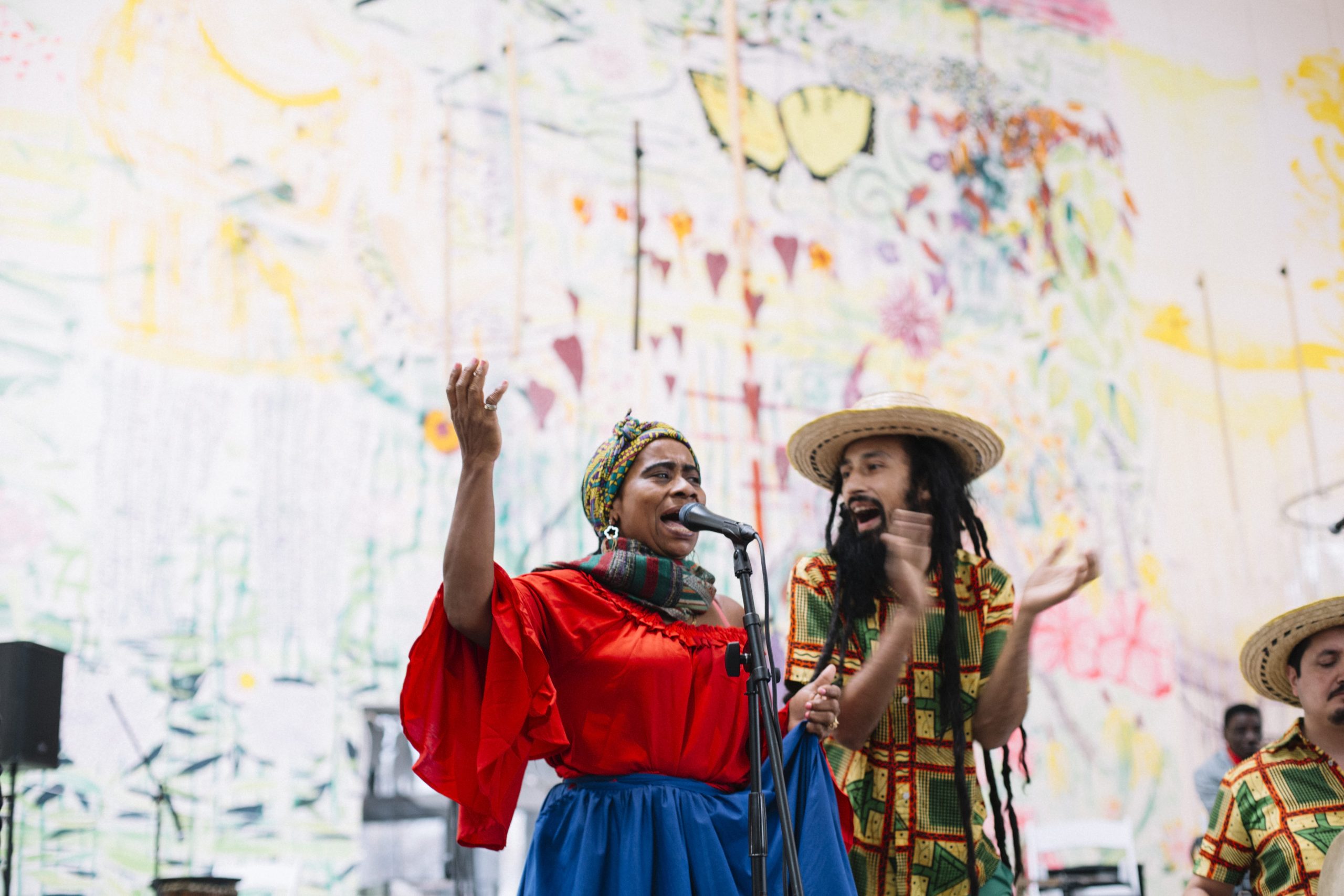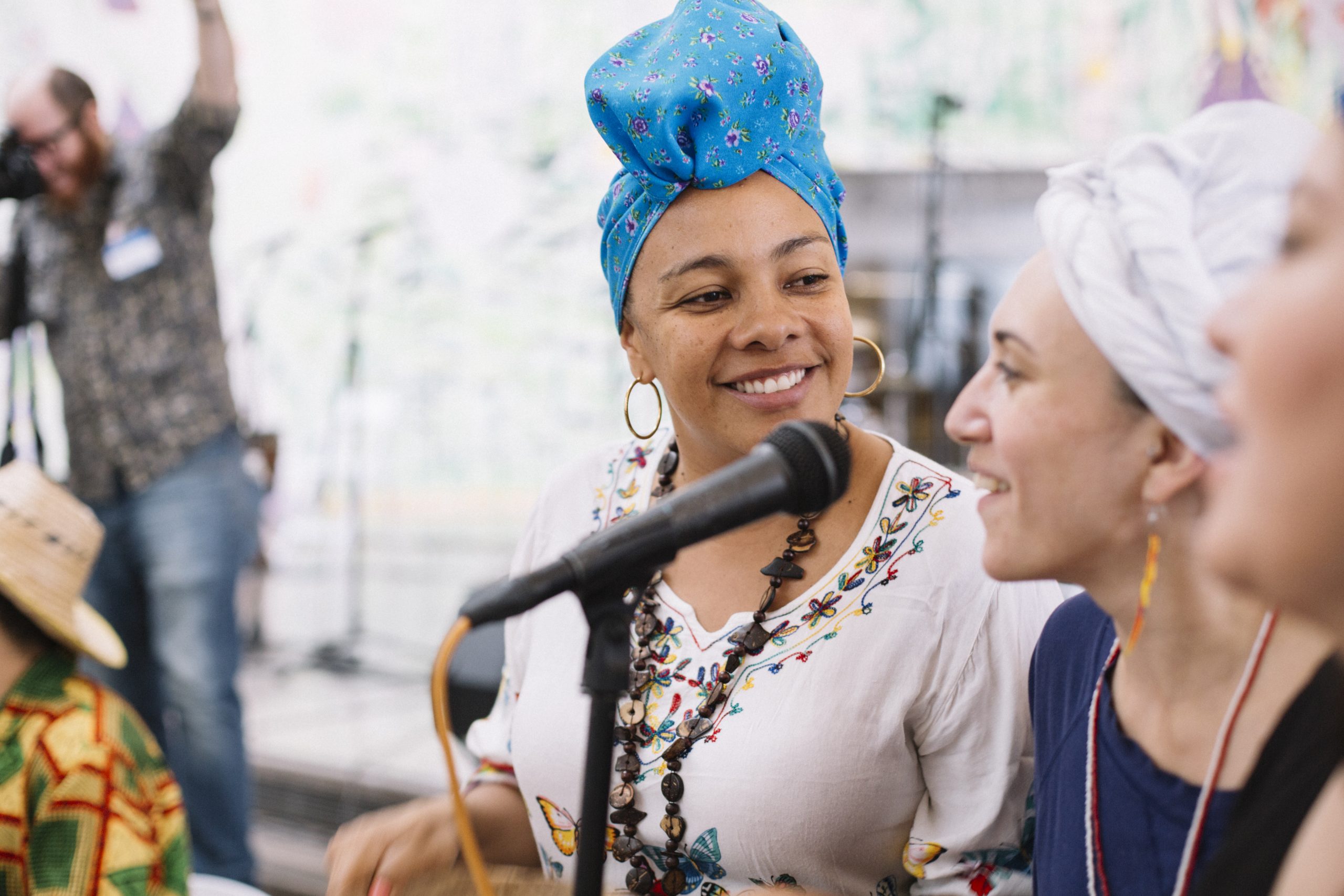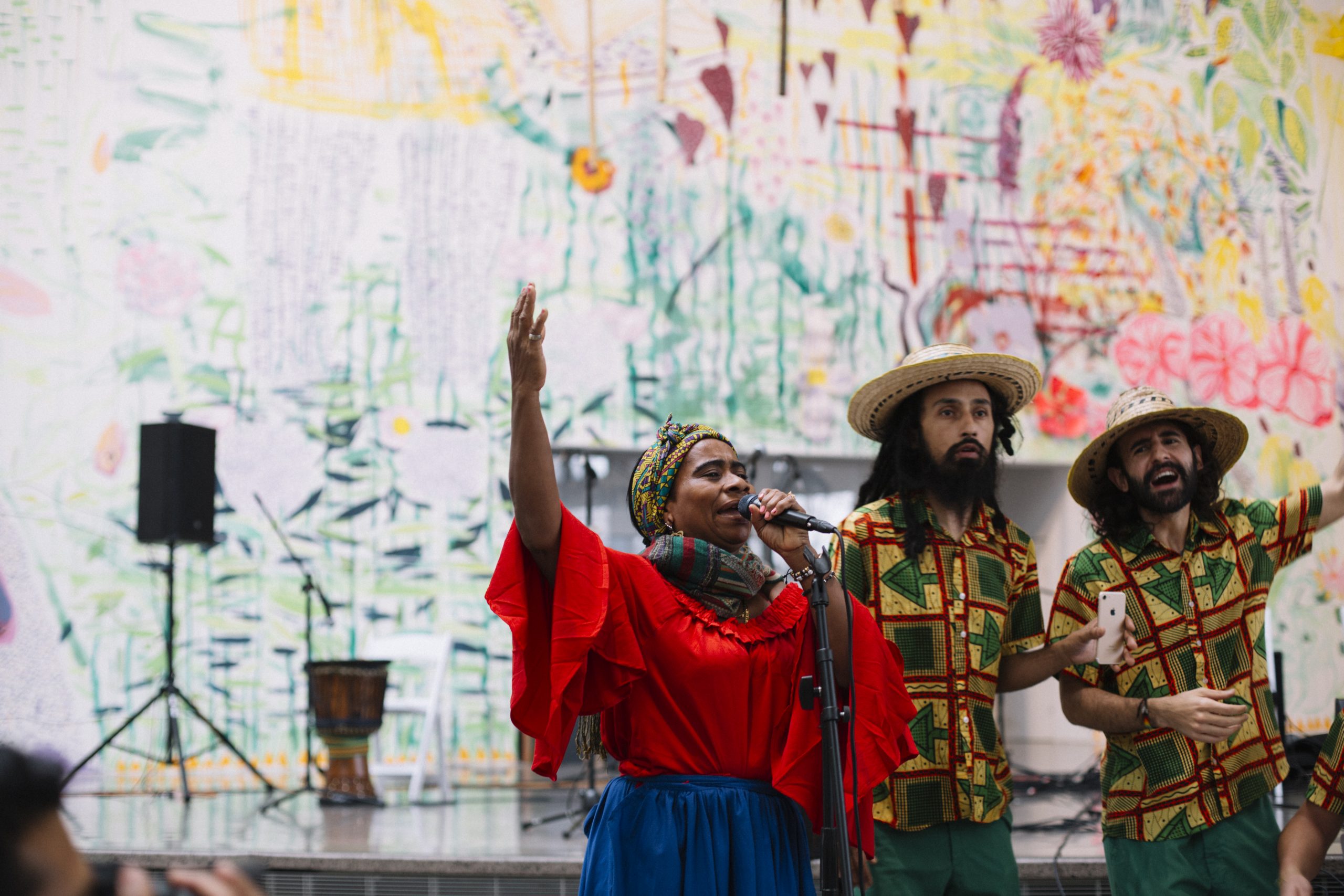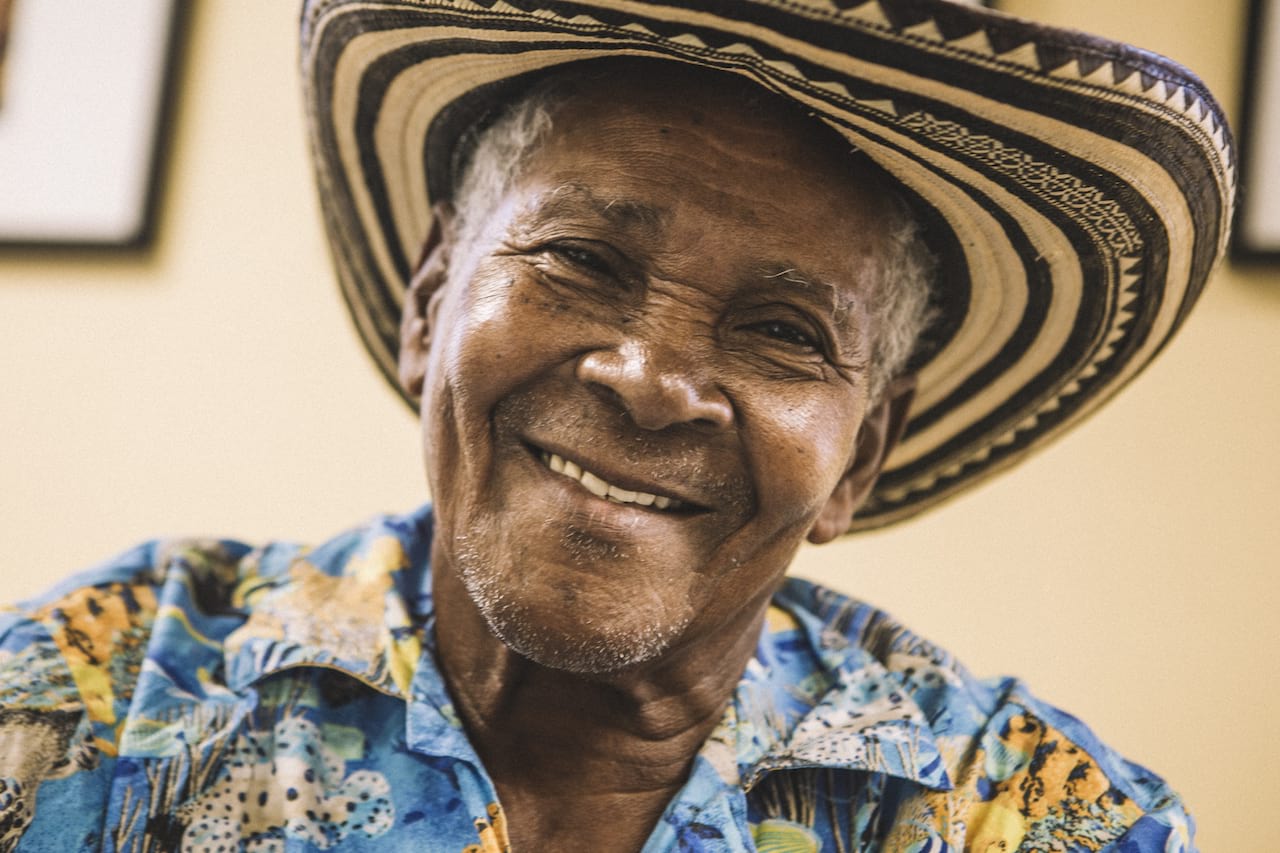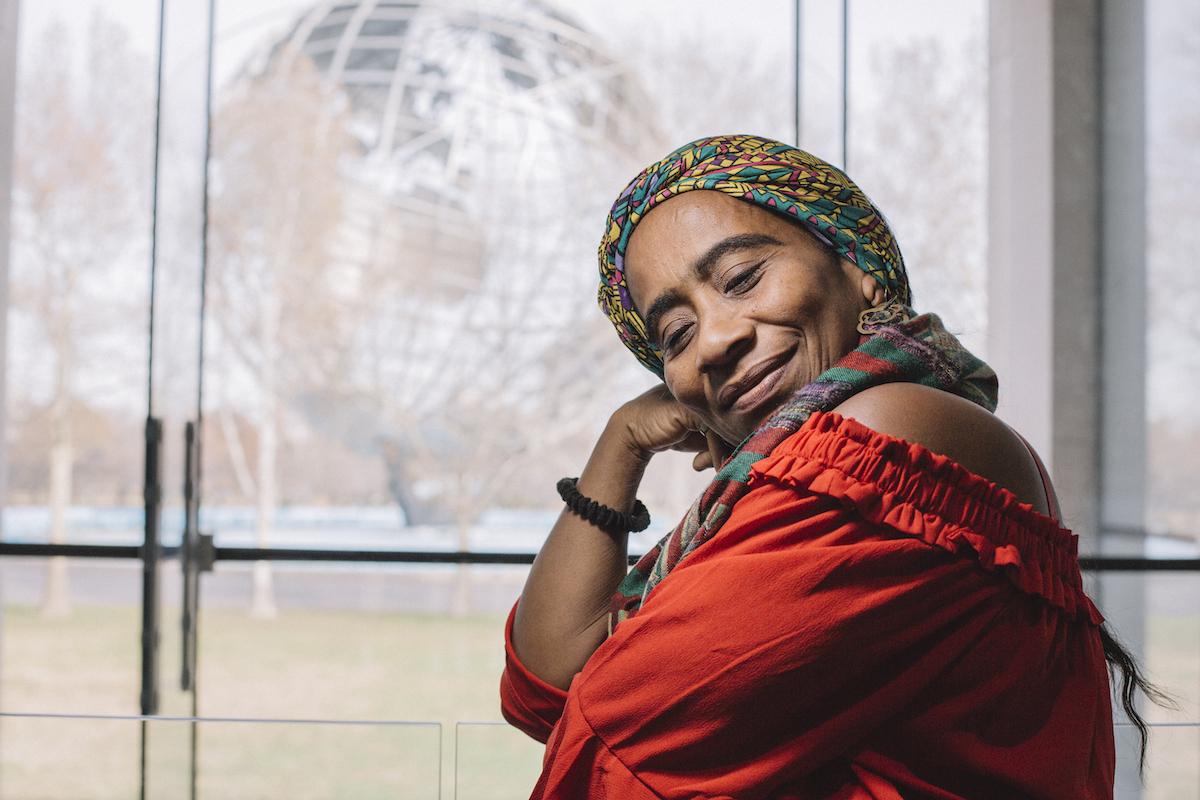
Darlina
Ms. Darlina Sáenz Garcés says that it is her song that brought her to New York City (NYC), a song that like the ocean waves, cannot be quieted in its quest to travel up and down the shore, before going out to sea. As one of Colombia’s great bullerengue masters, Darlina prizes, above all else, authenticity of self, when rendering songs that are part of this Afro-Colombian genre. The authenticity that Darlina speaks of, is a bit different than the one we infamously, and often problematically use the field of folklore. Darlina recognizes the importance and inherent difference in quality of a bullerengera/o (performer of bullerengue) who is not only raised in and around the tradition, but also adheres to certain repertory, stylistic, and aesthetic rules. She feels however, that it is even more central to the practice that a singer (or dancer) develop rapport with the audience and own the message of a song; actively transmit what they are feeling while singing it. She calls this type of authentic and personal communication with the public and fellow percussionists ‘sentimiento,’ or a type of profound feeling best communicated through this powerful tradition.
When asked to describe the Bullerengue tradition, Darlina comments, that it is literally “una bulla que alguien hace” (a loud noise that someone makes). Originating in Colombia’s Caribbean regions (and Panama’s Darién province), Urabá, Cordoba, Bolivar and Atlantico, bullerengue is a cumbia-based style of music and dance historically sung by women. It developed as a uniquely expressive tool for women to share their stories, frustrations, and ecstasies in daily life through song. The combination of guttural earthy vocals, syncopated hand drums and improvisatory dance, remains a largely oral tradition to this day and is one of the nation’s lesser known artistic exports.
Darlina Sáenz Garcés, daughter of famous bullerengue singer and composer Eloisa Garcés, is one of the scene’s major contemporary practitioners. Along with bullerengue dancer Andrea Villalobos Palacio, she traveled to the New York City for her U.S. debut as part of a Transnational Bullerengue Initiative tour organized by local bullerengue collective Bulla en el Barrio from November – December 2018. Our Los Herederos creative team was pleased to partner with Bulla en el Barrio to document the residency and produce this installment of Creative Masters in NYC, furthering the conversation about Afro-Colombian cultural heritage, artistic expressions and their intergenerational development in Colombia as well as in immigrant communities abroad. As usual we utilized a transmedia approach to our documentation and storytelling process. By capturing content in a variety settings from live concerts to more intimate 1:1 interviews, we took this opportunity to once again probe timely questions about the inheritance of tradition today.
This Transnational Bullerengue Tour allowed us to take a closer look at the transmission of tradition in our increasingly globalized and interconnected world, where the realities of being an immigrant or part of a diaspora change drastically. The combination of Darlina, Andrea, and the members of Bulla en el Barrio on one stage created the perfect foil to expose three layers of cultural inheritance, all embedded with their own helping of power dynamics and generational politics. We hope that this installment of Creative Masters in NYC pushes you to consider how traditions are passed on, and what about the essence of song and dance remain, when so many other factors are in constant flux.
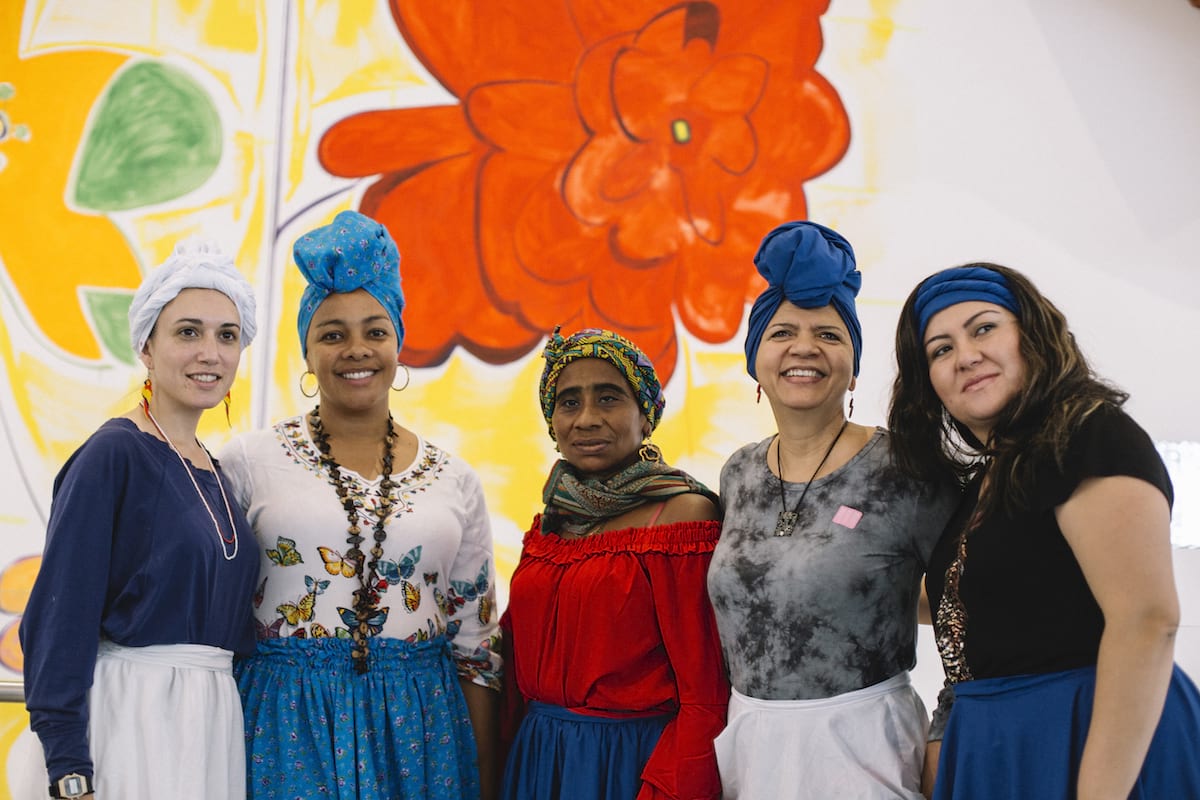
It is no accident that Darlina Sáenz Garcés’s chosen metaphors for bullerengue often employ the sites and sounds of the ocean. She hails from Necoclí, a small town in Antioquia, Colombia, located on the eastern shore of the Gulf of Urabá directly across the inlet from the border with Panamá. The municipality is known as one of the nation’s bullerengue hubs, and like so many others, literally sits at the mouth of the sea. Born to lauded bullerengue singer, author and composer Eloisa Garcés, it is said that Darlina emerged from the womb followed by her twin sister ____, singing (or perhaps screaming on pitch). Her mother and the doctor knew immediately that she too, would be a singer. Darlina grew up very close to her mother, who was also her first teacher and musical role model. The two often performed together alongside ____, and while Darlina would eventually develop a different musical trajectory, she followed in her mother’s footsteps sharing the tradition with her community and the world.
Following a brief move to Cartagena, Luisa brought Darlina and the rest of the family back to to Necoclí specifically to do bullerengue. As a performer, Darlina feels that the town has been very good to her and afforded her many opportunities. She spent many years working at Casa de la Cultura (Necoclí’s main cultural center) and like her mother, is part of the foundational bullerengue ensemble Palmeras de Urabá, which for approximately 32 years has produced many artists, teachers, and off-shoot ensembles. A regular at regional and national festivals for over five decades, Darlina is considered to be one of Colombia’s great cultural treasures. She is someone who grew up in the tradition. Some might say it is even in her blood. Her ‘sentimiento’ for the songs and their narratives comes straight from their source, her mother and their life as Afro-Colombian women living in rural coastal Colombia.
Andrea
Beyond the important work of Bulla en el Barrio to bring Darlina stateside, this particular voyage to NYC would not have been possible without the conscientious support of fellow bullerengue dancer and coordinator Andrea Villalobos Palacio. An accomplished performer in her own right, Andrea comes to the tradition from a different generational and sociological perspective.
Andrea calls herself an ‘adopted’ daughter of the bullerengue scene. She fully recognizes her urban roots and the educational and artistic formation that affords her access to resources and experiences beyond the average performer in Necocli. At the same time, she is very much a part of the changing constellation of the scene today, and has found ways to work respectfully within the inherent power structure. “It has not always been easy” she notes,
“working with Palmeras de Urabá can be a real challenge given that I and the elders come from such different worlds. When they made me the group’s director, I brought a level of administrative and financial professionalism that was absolutely foreign to the ensemble. This has in some ways altered the group’s presentation style and way of life, thus altering the tradition as it practiced in Necocli. I have to be honest and aware of that. It was a conscious choice that carried with it a conscious impact.”
Andrea clarifies that when community elders asked her to run the group, there was a real desire for an exchange of ideas and skills on the part of the master artists and herself. She was fully committed to learning the tradition and wanted to understand what would best sustain it from the inside out. The master artists were in turn, interested in making the group more financially and artistically sustainable, as they had fallen into a period of relative inactivity. And so understanding that there are pros and cons to any decision that alters an artistic practice, Andrea began to introduce new policies, accounting and a more formalized education and presentation program believing that was necessary for the continuity of the tradition in today’s world.
Bulla en el Barrio
As previously noted, Darlina’s U.S. debut was made possible by the hard work of an NYC-based bullerengue collective, Bulla en el Barrio, who since 2014 have been working to educate, research, and present bullerengue music in the U.S. as a communal learning process and immigrant experience. The group is made of up nearly 14 individuals of varying backgrounds, many of whom are Colombian artists living in NYC. Through their Transnational Bullerengue Initiative, Bulla en el Barrio brings bullerengue masters from the homeland to NYC to aid in this educational process. The project also creates an international artistic platform for the maestros that exceeds the type of support they regularly receive in Colombia.
Darlina’s ties to Bulla en el Barrio predate this initiative however, as one of their founding members, Carolina Oliveros, is her prized apprentice. Darlina met Carolina in much the same way she connected with Andrea, at a local bullerengue festival. Carolina was still living in Colombia at the time and straddled several music scenes from more traditional Afro-Colombian music, to rock, punk and heavy metal (see Inheritors: Carolina Oliveros). Not coming from a traditional bullerengue background, Carolina was still establishing herself in the local scene, when Darlina heard her sing. “There was something in her voice that hit me deep,” Darlina comments, “I heard that voice on stage and I thought, I must talk to that girl. She feels this music. She has the voice for it.” Following this chance meeting, the two formed an important bond and began to spend time together at festivals and gatherings. Darlina remarks on the early days of their relationship:
I remember how Caro used to want to model her ‘tonada’ or sound after mine. She would say, oh Darlina, I want to sing like you. I had to explain to her that the ‘tonada’ is something you can’t just teach, it’s ancestral. I can adjust how you sing, how you produce the sound and I can teach you certain techniques, but a person’s ‘tonada’ has to be genuine, authentic, all your own. It can’t be a copy of something you are not. I helped Caro build her own unique sound as a bullerenguera that embodies who she is.
Fast forward to 2019 in NYC, Darlina and Andrea greatly admire the work Carolina and Bulla en el Barrio are doing for bullerengue abroad. Darlina speaks with great pride about what a central role bullerengue plays in their lives and how to group is working to present a more nuanced perspective on Colombian music. As Andrea notes, ‘it’s not just cumbia and vallenato that are important, there are also older genres like bullerengue that should be recognized as ways of understanding Colombian culture, especially in immigrant communities living outside the country.” As we have seen in many immigrant communities across the globe, the experience of living outside one’s country often encourages a certain level of nostalgia and interest in cultural phenomenon that might have been overlooked or taken for granted while living in the homeland. For members of Bulla en el Barrio, bullerengue music is a unique means by which to rediscover musical roots while also expressing contemporary immigrant experiences through song. Darlina notes that this is why the ‘sentimiento’ a person brings to the music is so important. “As long as that is genuine, you can make bullerengue about who you are. That is the beauty of this tradition. It is open for transformation.”
Darlina regularly talks about how you ‘feel’ bullerengue with those around you. It is a practice in which the voice carries great sentiment and is used to communicate with the audience or the listener. What exactly is communicated however, depends partly on the lyrical content and partly on the message and the experience the performer is trying to convey. Like most good folk songs, bullerengue music can he interpreted and reinterpreted across generations remaining at once rooted in a particular cultural tradition and universally applicable to the human experience. Darlina states that one should pick airs and songs that speak to who they are in that particular moment. “Not every song is for everyone,” she notes.
Darlina certainly seems to have a knack for identifying young practitioners with the capacity to build this ‘sentimiento.’ Despite disparate upbringings and cultural backgrounds, she invested whole heartedly in Andrea, Carolina and now the members of Bulla en el Barrio. She and Andrea discuss at length, how the the different places, experiences and worlds they have inhabited make them who they are as performers and participants in the bullerengue scene. For both women, being NYC greatly enlarged this reality and impacted their formation. “It was such a unique opportunity,” remarks Andrea, “to collaborate with a group of musicians who while maintaining the essence of bullerengue, are singing for entirely different reasons, singing to tell different story, but a story all the same.”
May this be a lesson for all of us as we think about the multilayered, non linear, and increasingly complex experience that is the transmission of cultural traditions, in today’s global and digital world. Case studies and conversations like these echo some of the points made by Urian Sarmiento in our previous Creative Masters profile (see Paito en NYC: A Tale of Two Gaiteros), and continue to be important and timely discussions in the if field of folklore, ethnomusicology and applied cultural work. When confronted with generational shifts, aging master artists and traditions that are being phased out of everyday life, how do we make decisions and insert ourselves as professionals and collaborators in the quest to pass on knowledge? What do we do in cases where there is a lack of organic leadership in a community? How can we be critical of social dynamics and traditionality, while not getting bogged down by preservationist attitudes that often impede transmission and evolution of tradition?
